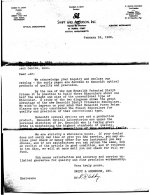Sandy Leng
Well-known member
I have only recently discovered this forum, and have really enjoyed the superb thread by Ed and Renze on the history of the Audubon.
I'm sorry if this sounds naive, but I understand that Swift is an old American company, but having read the thread I realise that the binoculars were designed by Tamron, and the prisms, lenses and the magnesium body all made in Japan.
Did Swift assemble the binoculars in America, or were they assembled in Japan?
We build Toyota cars in England, but they are made from Japanese components, and even though built by British workers they will always be a Japanese car.
I look at my old 804 Audubons in a different way now that I have read Ed and Renzes thread, I just wonder where they were born!
Clive.
I'm sorry if this sounds naive, but I understand that Swift is an old American company, but having read the thread I realise that the binoculars were designed by Tamron, and the prisms, lenses and the magnesium body all made in Japan.
Did Swift assemble the binoculars in America, or were they assembled in Japan?
We build Toyota cars in England, but they are made from Japanese components, and even though built by British workers they will always be a Japanese car.
I look at my old 804 Audubons in a different way now that I have read Ed and Renzes thread, I just wonder where they were born!
Clive.





